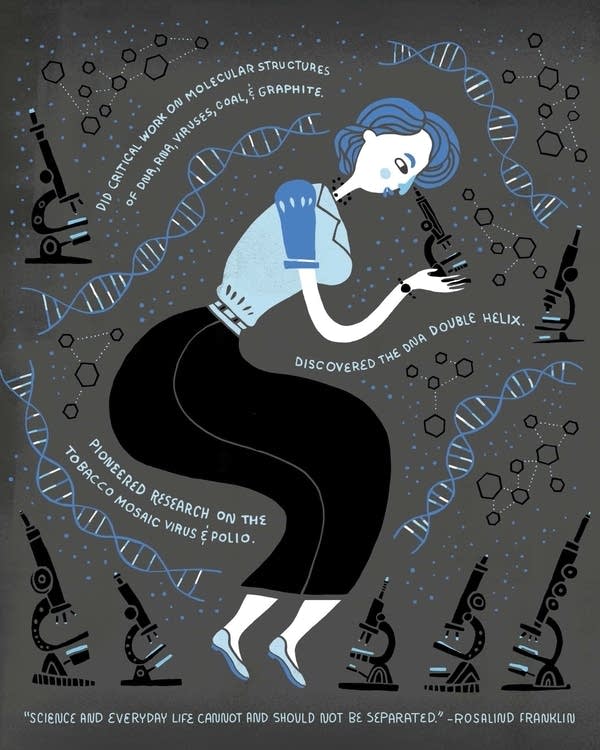An illustrated ode to women in science

Mary Anning discovered her first complete dinosaur fossil when she was 12 years old.
Katherine Johnson cracked calculations that allowed men to land on the moon — even though she wasn't allowed in NASA meetings.
Katia Krafft risked her life photographing volcanic eruptions, getting closer than anyone else dared.

These women are just a few of those profiled in Rachel Ignotofsky's new book, "Women in Science: 50 Fearless Pioneers Who Changed the World." Each profile includes an eye-popping illustration of the women in their element — surrounded by petri dishes, supernovae, microscopes and isotopes.
Create a More Connected Minnesota
MPR News is your trusted resource for the news you need. With your support, MPR News brings accessible, courageous journalism and authentic conversation to everyone - free of paywalls and barriers. Your gift makes a difference.
Intended for children 10 and up, Ignotofsky's book is an irresistible resource for curious readers of any age. Arranged in chronological order, the 50 profiles document women's achievements in science from Egypt in A.D. 350 to the modern era.
The project started with a question, Ignotofsky said: Why is there still such a gender gap in science and mathematics? According to the 2011 census, 76 percent of the STEM (science, technology, engineering and mathematics) workforce is men.
"I think the best way to fight gender bias is to introduce young girls — and boys — to strong female role models," Ignotofsky said. "The message of the book is: Ever since ancient Rome, women have been contributing to these fields — and you can, too."

An illustrator by trade, Ignotofsky started with art: Two years ago, she began crafting lively portraits of women scientists and selling them on Etsy. The response was immediate and enthusiastic. Customers snapped them up for their kids' rooms — and for their own cubicles.
When she began to compile them into a book, it was daunting to pick just 50. "I could have filled a book with just women chemists or just women in the space program," she said. In the end, she winnowed it down to profiles that showcased a wide breadth of history and subjects.
"I wanted a range of topics: I talk about volcanoes, marine biology, genetics. There's going to be at least one person in this book that every kid is going to learn about and go: 'Whoa,'" she said.
Alongside better-known trailblazers like Marie Curie, Rosalind Franklin and Mae Jemison are rarely noted figures like oncologist Jane Cooke Wright, astronomer Vera Rubin and particle physicist Sau Lan Wu. The profiles pull readers through history — women's suffrage, World War II, the Civil Rights movement, the Space Race.
Ignotofsky's own personal favorite is Katherine Johnson, an African-American physicist who worked for NASA in the 1950s.
"At that time, there was 'men's work' and 'women's work' at NASA — and in most places," Ignotofsky said. Johnson wasn't allowed to attend planning meetings, even though she was crunching numbers and calculating critical data for those same meetings.

Finally, she asked her supervisor if attending one of the meetings was against the law. He said no, so she showed up.
"She went in and started asking questions," Ignotofsky said. "She actually calculated the flight path for the Apollo missions. Her calculations got men on the moon."
This November, just before Ignotofsky finished her illustration of the pioneering physicist, Johnson was awarded the Presidential Medal of Freedom.
"I got to draw it in right before it went to the printers. She's really an inspiration: She went from not being even allowed in the room to winning a Presidential Medal of Freedom. I think a lot of people can learn from her to never take 'no' for an answer."
Women in Science Women in Science


